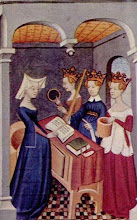Things happened, Life occurred. We appear to have stabilized, although the current house has much less crafting space. Let's take on a big big project and find out how that's going to affect things.
This is Marie d'Assigny, Madame de Canaples painted by Jean Clouet in (roughly) 1525.
Every now and then one of those "Who were you in history?" quizzes crosses my media and I always get this picture. Admittedly, we share a similar number of chins and something around the cheekbones. I've been trying to stay in the 1490-1500 range for awhile, but that dress really does look sharp. So I lost my mind and started working out how to build it.
What I see in the portrait is three layers.
Layer One: I see a square necked smock/ camicia/ shirt thing with a blackwork band and a gold edging. I made a smock using the pattern for a 16th century Venetian camicia found here: Realm of Venus
It was fast! It required very little math! It was... gathered into a neckband that couldn't disguise it's lumpy, bumpy weirdness. This was NOT the fault of the pattern. I figured out I skipped a step in the gathering stage and didn't tack it down and sew it flat BEFORE I put the neckband on. Still not sure how I missed that step, but it had to change. I pulled the neckband off, smoothed my gathers into pleats, tacked them all down and reattached the neckband.
Currently I'm in the process of marking out the blackwork on the neckband. The embroidery doesn't look very hard to do. It appears to me to be a series of half circles, superimposed on one another, with leafy bits added. Like so...
Layer Two: This is the layer that is giving me stress. From what I have read, this should be a supporting layer, a boned and structured kirtle that will provide the support needed and smooth things out to create that conical shape so beloved of the period. In the English portraits of about that same time period, the kirtle clearly is either a side or back lacing gown with all the support built into the front.
See the yellow kirtle under Anne Cresacre's 1527 gown here:
However, Madame's kirtle is pretty clearly a front laced kirtle. Not only that, but the lacing is WIIIIIDDDDEEE apart in the front. I don't think it even comes over as far as her nipple-line in fact. It's possibly built like a German or Venetian gown of roughly the same period, but I just can't tell.
And then there's this 1490 Portuguese lady dressed in black with the super-wide lacing dress as well:
Layer Three: The outer layer of the dress is a dusty rose large patterned brocade. The dress looks like a version of the Queen Jane dress with it's structured, lightly-boned front-lacing bodice that has a pinned stomacher over it and the excessive two or three part sleeves.
I've already done a version of this dress years ago and with much less information on how it was supposed to go together so I'm not very worried about that top layer.
This is a picture from 2011 of the Six Queens event I co-hosted. I'm the one in all red. Yep, that dress is all kinds of wrong now that I look at it, but I was very proud of it then. I keep it to remind myself that I can be proud of older work too, even if I always try to do better the next time.
I haven't really gotten into the hoops/ no hoops issue on this dress yet. My research says HOOPS, my desire to have it all done and wearable says NO! Hoops will probably win, but I'll grump about it.
Let's see what happens!
Tuesday, August 14, 2018
Subscribe to:
Post Comments (Atom)







No comments:
Post a Comment